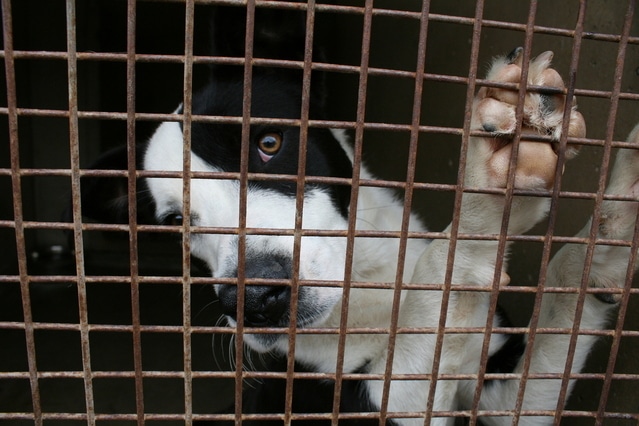When bringing home a new puppy, you will have some tough decisions to make about training, and the means and tools you will need to accomplish this important task. One of the most difficult decisions to make is crate training the puppy.
Crate training is cruel when used as a punishment, the smart use of the crate can make it a valuable tool for home training and provides a safe environment for your puppy to rest relax, and feel safe. It also allows the owner to enjoy peace of mind so he doesn’t have to be constantly supervising the dog’s every move.
Using a crate can be a challenging task especially for inexperienced pet owners, so continue reading for some incredibly easy tips to making the crate a happy place for your puppy.
Is crate training really cruel?

Let’s elaborate on this idea, and why some people may reject the crate training.
Some dog owners feel that the crate is like a prison for their lovely puppy; however, dogs have different needs and don’t evaluate the place based on how it is but the sort of experiences they associate with such a place.
Meaning if the crate is a place where the puppy has had a great time it would make it a favorite place where he may spend hours deliberately.
So it all comes down to associating the crate with super happy memories such as food, toys and so on…
Furthermore, dogs are naturally denning animals that tend to find a private place where to just relax and you may have had noticed this in dogs when they are tired they just retreat to a calm place behind a couch or under a table.
Now that we know that crate training is not cruel; why would you do it anyway?
Is crate training necessary?
Crate training may not be necessary but it is strongly recommended.
It is like a default mode when a beginner is dealing with new software.
Experienced dog trainers and dog owners that have had enough interaction with dogs to know how to establish order and communication with their pets without the use of a crate.
Although most dog trainers do use the crate training in their programs and furthermore they encourage using it.
All this proves once more that crate training is not cruel. Since the experts are using it.
Crate training benefits for the dog
As we mentioned earlier dogs tend to find a denning place on their own, so providing one that you can control is a great idea since they no longer have to be stuck in one place especially when that space isn’t respected when having guests or other pets around.
- The crate provides intimacy and a safe place for your puppy.
- When it’s the perfect size the crate can help with the potty training.
- The crate is great for travel and safety when on the road.
- The dog can relax while being around the family.
Crate training benefits for you
Dogs need much attention especially at an early age, having to supervise its very movement can be stressful.
That’s where the crate comes in handy as it allows you to:
- Have the puppy safe and secured while doing work around and outside of your house.
- Establish good communication and basic rules in the early communication building phase.
- Including the puppy in family activities in and outdoors.
- Have some free time when around guests and concentrate on other things.
How to make the crate a happy place?
Dogs tend to evaluate places based on experience, and you can easily conduct behavioral changes toward a certain place simply by associating feelings to it.
So the first thing would be to avoid punishing or yelling at the puppy when in the crate.
You also want to make it the happiest place by feeding your puppy meals in his crate.
Try to reward the puppy with treats every time they get in there, after a while depending on the dog they will offer to get in there on their own to get the treat.
Don’t force the puppy into the crate take things easy and slow and let him take his time exploring it.
You can feed the puppy his meals in the crate; food is a great element in crate training; the feeding time is an intimate moment and if associated with a place it makes it very difficult to break that bond.
You can put in the puppy’s favorite toy so he can enjoy himself in there. Playtime outside is very important a chewing toy is just to avoid boredom.
Always exercise the puppy enough to make the crate a relaxing time, you don’t want your puppy to feel trapped while high on energy.
Don’t let your guilt get in the way

I am going, to be honest about it I did do the same mistake with my first puppy years ago; I was like I won’t put my dog in a box, I’m a responsible dog owner.
And boy he was tearing things apart in the house when I’m gone to work, I’ve tried everything still he was always frustrated.
I mean I had nice play sessions and everything to lower down the energy but still, the dog was just not at ease at all.
So I had advice from a colleague who had had plenty of dogs at the time and when he suggested the crate training I was like not a chance.
Then I told him that at that point I was leaving him in the bathroom to control a bit his environment so he told me something I’ve never forgotten; he said you are crating the dog it’s just a bigger crate for you to feel ok.
So yeah when thinking about it the more you control the dog environment the better he is dealing with daily challenges.
And dogs don’t care about space because I’ve got a big garden and still he often went to a dark corner in the garage, this, of course, doesn’t mean a dog should be crated all day long but, they just need a place to relax when they feel down.
Too much crate training is cruel

We defiantly encourage crate training and find it to be the best way to control a dog’s environment and achieve incredibly fast progress with the home training.
However too much of anything turns bad, and crate training is no exception.
Dogs are denning animals, but also very energetic and playful, locking the dog in a crate all day long because you don’t feel like playing is cruel.
Normally the crate is for the dog to relax when he is down on energy or worried … not a cage, it’s like your bedroom no matter how great and cozy it is if you spend all day in bed you’re going to feel depressed.
This is actually why most people have a bad opinion on crate training as we all witnessed the irresponsible dog owners that leave the dog crated while at work then take the dog for a potty break only to be crated again as the owner goes out or does something else.
How long can a puppy be in his crate
This question is often asked by people who actually have to leave their puppy alone for some time with no supervision.
Crating a puppy too much especially at a young age can really harm your dog, so we want to be careful how long we do it.
The typical crate time for a puppy who’s 8 weeks old is about an hour every time, meaning an hour in the crate then playing sessions and potty time feeding then another crate session of an hour.
The older the puppy gets the more time he can spend in there and we can go gradually following the one hour per month rule.
So a 3 months old puppy can be crated for about two hours, and a 4 months old puppy for 3 hours and so on up until they reach six months where they actually can tolerate longer sessions which is very helpful for people who have to go to work.
If you leave your puppy while at work(of course if he is six months and older) you only have to do it once a day meaning when you come home he doesn’t go back in there until his bedtime.
Crating a young puppy for an extended amount of time can and will severely harm him.
Is crate training a puppy all night cruel
Dogs aren’t really energetic during the night, which makes crating during the night perfectly OK. Old enough dogs may sleep through the night without even waking for a potty break.
Young two to four months old puppies(depending on the breed) will need to go out and eliminate once or twice during the night but have no problem with spending the night in a crate.
In the morning and during the day puppies are very energetic and playful so as mentioned earlier crating for too long may harm your puppy.
Crate training during the night may be a difficult task though especially for a new puppy; you can check our article about crate training a puppy first night it has some very informative details and a step-by-step guide to how to achieve that.
Crating the puppy while at work
Now, this is by far one of the most difficult situations to deal with when crate training a puppy. because all that we’ve said early on is not compatible with this situation.
Some young puppies can be left in the crate for more than 2 to 3 hours, so how can a working dog owner deal with this situation, from one side you want your puppy safe while at work but also don’t want to over crate not to harm him.
You actually have four options to deal with the situation :
Option 1: Flexible working hours
If you do have flexible working hours you can come home at lunch let the poppy out to exercise potty and have his energy down then go back for another crate session, which is fine as we said early on the 3 hours isn’t per day but session.
Option 2: Having a friend coming over
If you can rely on a friend to take the puppy out of his crate spend some time with him, that would be perfect if you can’t manage to come home during work.
This is temporary as your dog gets older he can manage longer crating hours.
Option 3: dog sitter
There are plenty of dog sitting services you can find for cheap prices or even a kid in the neighborhood if reliable.
There are also places where you can drop your dog during work and take him out later, some are great as they help with the training, and the puppy gets to be around people and other pets which is helpful if you have guests and other pets.
Option 4: installing a large playpen
The playpen could be a great alternative solution if none of the previous options is possible.
Just make sure to have a large enough playpen for the puppy to move around play a bit with toys you may through in there and have the crate inside for his crate time.
You want to make sure the playpen is dog-proof to avoid any unfortunate accidents.
Crate training when done correctly, is not cruel
- The intelligent use of the crate is a great tool to manage and control the dog environment and make him more receptive to training.
- Making the crate the perfect den is essential in the crate training process.
- Leaving the dog in the crate too much is harmful.
- Using the crate for time out is a big mistake that can be difficult to recover from.
All in all crate training is good for your puppy but overdoing a good thing turns it bad.
Get to know your puppy better analyze his needs, and personality, not all dogs are the same and be there for him and things should go smoothly.






